Posted on August 3, 2017 by Mitch Kersey
The U.S. has already demonstrated that innovation is an effective weapon for reducing emissions. Federal natural gas research programs that occurred almost half a century ago have driven a 24.7% reduction in power sector carbon dioxide emissions in the U.S. from 2005 to 2016.1 The U.S.-pioneered shale gas revolution represents the blueprint to the further clean energy revolutions we will need to meet global emission reduction objectives.

Source: BPC2
How exactly do these breakthroughs happen? One tool is the Department of Energy itself. The Department funds basic and applied research at 17 National Laboratories. Scientists at these laboratories pioneered nuclear energy and medicine, the battery technology in electric cars, and the MRI machine, among many other technologies.3 The Manhattan project, conducted at what are today National Laboratories, led to the harnessing of nuclear fission and the first electricity producing nuclear reactor in 1951.4 Engineering companies like Westinghouse and General Electric ran with this technology; as of 2018, nuclear reactors provide 19% of electricity generation in the U.S. and the largest source of emissions-free electricity on the U.S. grid.5
The Department also funds grants to research institutions across the U.S., including companies in the early stages of developing innovative technology. For example, the DAYS Program under the Advanced Research Project Agency-Energy (ARPA-E) gives grants to companies, universities, and laboratories across the U.S. to improve long duration energy storage systems. Some of these projects could provide storage for up to 25 times longer than the average battery today, lengths that could revolutionize the grid’s flexibility, reliability, and security.6
For developers who are closer to commercialization, the Department of Energy offers both funding or technical assistance. Tools include public-private partnerships and laboratory “vouchers” that allow private companies access to lab facilities at no cost.
Vouchers can focus the Department’s wide resources on targeted breakthrough technology. An advanced nuclear voucher program7 provides developers of advanced nuclear reactors and related technologies access to ten national laboratories. This access allows developers to run complicated tests to hone their designs to reduce the technical and financial burden of achieving commercialization. A company making microreactors for remote Alaskan villages and modular reactors that can be added like Legos have been able to ready their designs for near-term licensing and deployment. More than ten additional developers have modelled and tested key elements of their breakthrough designs for deployment in the next decade.
Public-private partnerships on groundbreaking projects have already led to massive emissions reductions. In 2019, the Department of Energy partnered with Mitsubishi to deploy the first commercial-scale carbon capture plant which has captured as much carbon dioxide as over 400,000 trees. Other companies are following suit by developing carbon capture projects at commercial scale. The leap from innovative idea to innovative project can be vast; public private partnerships can bridge that gap for others to follow.

Long-duration energy storage: New ways of thinking about energy storage technologies could contribute to almost exponential growth — utility-scale storage is expected to triple by the end of 2023.8 California-based company Quidnet combines drilling and pumped hydro storage technologies to make artificial pumped storage in old oil and gas infrastructure. Quidnet has received funding from the ARPA-E DAYS Program for their geomechanical pumped storage to make this technology deployable and instantly dispatchable at grid scale.9 For more information on Quidnet and long-duration energy storage, check out this video.
Nuclear: A new type of fuel, TRISO fuel, was developed at national laboratories. It cannot melt and retains its fission particles, allowing TRISO-fueled reactors to be even safer and more resilient.10 Today, the Department of Energy is partnering with nuclear engineering company X-Energy to design a TRISO fuel fabrication facility for the many advanced reactor vendors who will need it in the coming decades.11
Marine Hydrokinetics: The Water Power Technologies Office at the Department of Energy is developing technologies to harness wave, tidal, and river and ocean currents, which could unlock 500-750 TWh of electricity each year.12 The PacWAVE testing center off the coast of Newport, Oregon is piloting this wave energy to electricity conversion. The center is connected to the grid under a twenty-five year license, providing ample opportunities for innovative technology development.
Carbon capture technologies that can pull emissions straight from the air (“direct air capture”) could contribute to not just net zero, but negative emissions. Some startups could displace the equivalent of pulling over 200,000 cars off the road.13 Building at scale will help decrease costs, as will returning to the basics: research into basic materials can lower costs and accelerate global deployment.

